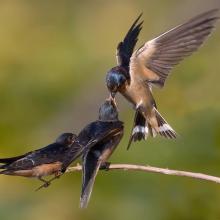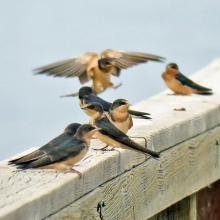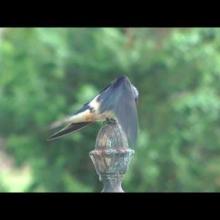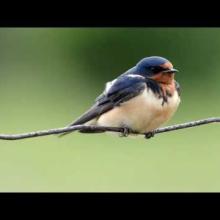

Join BirdNote tomorrow, November 30th!
Illustrator David Sibley and actor H. Jon Benjamin will face off in the bird illustration battle of the century during BirdNote's Year-end Celebration and Auction!
Through all of spring and summer, swallows dart and sail overhead, their airborne grace a wonder to behold. But by October, the skies seem empty. Most swallows have flown south, in search of insects. The eight species of swallows that nest in the US - including this Cliff Swallow - migrate south to Central or even South America. Watch for them again next spring!
BirdNote®
Where Swallows Go in Winter
Written by Bob Sundstrom
This is BirdNote!
[Calls of Barn Swallows]
Are any birds more conspicuous by their absence than swallows? Through all of spring and summer, swallows dart and sail overhead, their airborne grace a wonder to behold. [Continue Barn Swallows]
So while October marks a lovely juncture in the change of seasons, the skies seem empty. The swallows have flown south.
Swallows feed almost exclusively on flying insects, abundant in the warmer months, scarcer as fall takes hold. The swallows – eight species nest in the United States – must fly south for the winter, to latitudes where aerial insects are to be found.
[Song of Tree Swallow]
So, if you wanted to follow the swallows in winter, where would that journey take you? [Violet-green Swallow runs in background] Well, to catch up with Violet-green and Tree Swallows, you would traverse much of Central America. A search for the other six species would take you through much of South America. Indeed to see Cliff Swallows, you would have to strike off as far south as Argentina. [Calls of Cliff Swallow colony]
For a parting look at swallow flocks in early October, visit the sort of places they concentrate before migrating. Check around large open fields or pastures, or wetlands like marshes or ponds – for a last chance to say farewell until next March or April.
[Continue Barn Swallows]
###
Bird audio provided by The Macaulay Library of Natural Sounds at the Cornell Lab of Ornithology, Ithaca, New York. Barn, Violet-green and Cliff Swallow recorded by G.A. Keller. Tree Swallow recorded by G.F. Budney.
Producer: John Kessler
Executive Producer: Chris Peterson
© 2014 Tune In to Nature.org October 2016 / 2021 Narrator: Michael Stein
ID#101706swallow swallow-02b-2010-10-13








